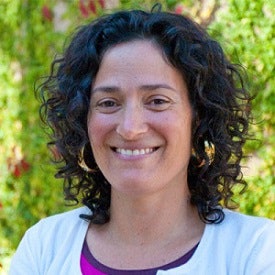California leads the nation in offering college opportunities to incarcerated and formerly incarcerated students, according to a recent joint study by the Stanford Criminal Justice Center and The Opportunity Institute.
As of fall 2017, nearly 4,500 incarcerated state prison inmates in California were enrolled in face-to-face community college classes in 34 of the state’s 35 prisons, the study showed.
 Debbie Mukamal
Debbie MukamalThe new findings are a sharp contrast to 2014, when only one California prison had a face-to-face college program, run by a private university.
“In just three short years, California has built a new generation of college students and graduates, creating onramps to redemption and prosperity for thousands. Early data shows that incarcerated students are doing as well as or better than their on-campus counterparts, including earning higher grades,” said Debbie Mukamal, executive director of the Stanford Criminal Justice Center and co-author of the report.
Hundreds more are waiting to enroll, she said.
Corrections to College California is a project of “Renewing Communities,” a four-year initiative undertaken jointly by the center and the institute and funded by 13 state and national foundations.
Mukamal said the new educational opportunities are expected to benefit the students and society in the long run.
“It not only gives them critical thinking skills that helps them navigate making decisions in prison and out of prison, it transforms their identity. They can now be a student rather than an offender,” she said. “It enables them to have all the benefits a college degree can bring, including success, social networking and to move up in the labor market from warehouse and fast-food jobs.
“It’s good for the economy. These are individuals we don’t want to overlook.”
Thousands of formerly incarcerated students are attending the University of California (UC), California State University (CSU), and California community colleges. A third of the state’s 114 community colleges and CSU campuses now have student groups or support programs for formerly incarcerated students, with students throughout the state confronting the stigma of incarceration and advocating for a second chance through California’s public colleges and universities.
 Rebecca Silbert
Rebecca Silbert“I was more scared to walk onto a college campus than onto any prison yard, but I was lucky to have a mentor who connected me with other students who had been incarcerated,” said Spencer Layman, who graduated from San Bernardino Valley College and now works as a substance abuse counselor. “Some people will say that my success makes me an exception, but I am not. There are thousands of men and women just like me who can and want to turn their lives around. We just need to give them an opportunity to succeed.”
The study finds that California’s exponential growth in students who are or were incarcerated is a result of three state policies that could be replicated nationally:
- In 2014, Gov. Jerry Brown signed a law allowing community colleges to offer face-to-face courses inside state prison and to be compensated for teaching incarcerated students just as if they were on campus.
- California’s public colleges and universities have no undergraduate admissions barriers for students who have been in the criminal justice system.
- Low-income incarcerated students are eligible for the California College Promise Grant just like any other student in the state, which covers community college tuition. California is the exception. Nationally, individuals with a criminal conviction are ineligible for Pell Grants unless their college is one of 67 that participate in the Second Chance Pell Pilot Program. California’s experiences indicate what the rest of the nation could accomplish if the ban on Pell Grants for students incarcerted in state or federal prisons is lifted.
Mukamal said the study, co-authored with Rebecca Silbert, a senior fellow at The Opportunity Institute in Berkeley, will hopefully lead to further research and highlight possibilities in other states.
“It is the colleges, the jails, the prisons that are doing this work. It’s not really about us,” Mukamal said.
Such initiatives could help cut universally high recidivism rates. In California, for example, the rearrest rate of former state prison inmates is over 60 percent within two years of their release, the study notes. Approximately 700,000 Californians are in jail or prison or under criminal justice supervision on any given day – and the majority are Black and Latino men with an average age of 39, according to a 2013 report by the state’s Department of Corrections and Rehabilitation.
The partnership between the Stanford Criminal Justice Center and The Opportunity Institute began when Doug Wood, a program officer from the Ford Foundation, went to California and learned that the state had a face-to-face college program – run by a private university – in one prison.
“Rebecca and I were given a grant from Ford to examine the landscape of the criminal justice and public higher education systems to analyze how to increase the number of college opportunities available to incarcerated and formerly incarcerated students in California,” Mukumal explained. “At the time, Rebecca was working at the Warren Institute at Berkeley Law, but then moved over to The Opportunity Institute. Fortuitously, our work coincided with the passage of SB 1391 – the law that gives the community colleges the ability to teach face-to-face inside custody and to receive apportionment for the students who are incarcerated just as if those students were enrolled on campus.”
Said Silbert: “We can’t stop now. We owe it to ourselves and to those who are changing their lives to make sure that degree pathways in our public colleges and universities remain open to incarcerated and formerly incarcerated students into the future.”





















